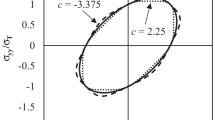Abstract
The analysis of the strength of adhesively bonded joints depends to a large degree on concepts of linear fracture mechanics. This discipline rests on appropriate fracture criteria and their evaluation in terms of the linearized theory of (visco) elasticity. We document here the technique and the instrumentation that allows close experimental scrutiny of the linearity assumption as well as an exploration of criteria for interfacial unbonding.
Similar content being viewed by others
References
Bikerman, J.J. Experiments in Peeling, J. Appl. Poly. Sci.,2,216–224 (1959).
Kaeble, D.H., Peel Adhesion, Adhesives Age, 37–42 (May 1960).
Kobatake, Y. andInoue, Y., Mechanics of Adhesive Joints, Part IV: Peeling Test, Appl. Sci. Res. (A),8,321–338 (1959).
Ripling, E.J., Mostovoy, S. and Patrick, R.L., Measuring Fracture Toughness of Adhesive Joints, Mat. Res. and Standards, 129–134 (March 1964).
Williams, M.L., The Continuum Interpretation for Fracture and Adhesion, J. Appl. Poly. Sci.,13,29–40 (1969).
Jemain, W.A. andVentrice, M.B., The Fracture Toughness of Adhesive-Bonded Joints, J. Adhesion,2,106 (1970).
Ripling, E.J., Corten, H. andMostovoy, S., Fracture Mechanics: A Tool for Evaluating Structural Adhesives, J. Adhesion,3,107–123 (1971).
Mostovoy, S., Bersch, C.R. andRipling, E.J., Fracture Toughness of Adhesive Joints, J. Adhesion,3,125–144 (1971).
Stone, S.E., Westmann, R.A. and Fourney, M.E., Analytical and Experimental Studies in Adhesive Mechanics, UCLA-ENG-7556, Univ. of CA, L.A. (1975).
Romanko, J., Behavior of Adhesively Bonded Joints under Cyclic Loading, AGARD-LS-102-Bonded Joints and Preparation of Bonding, 4–1 (1979).
Sykes, J.L., Greene, G.W. andChow, C.L., Experimental Techniques and the Mixed-Mode Fracture of Adhesive Joints, VDI Berichte, 313, 503–509 (1978).
Sommer, E., An Optical Method for Determining the Crack Tip Stress Intensity Factor, Engrg. Fract. Mech.,1,705 (1970).
Packman, P.F., “The Role of Interferometry in Fracture Studies,” Experimental Techniques in Fracture Mechanics 2, ed. A. Kobayashi, SESA Monograph Series (1975).
Patoniak, F.J., Grandt, A.F., Montulli, L.T. andPackman, P.F., Fatigue Crack Retardation and Closure in Polymethylmethacrylate, Engrg. Frac. Mech.,6 (4),663–670 (1974).
Liechti, K.M. and Knauss, W.G., “Crack Propagation at Material Interfaces II: Experiments on Mode Interaction,” Cal. Institute of Tech., Passadena, CA, GALCIT Report SM 80-21.
Crosley, P.B., Mostovoy, S. andRipling, E.J., An Optical Interference Method for Experimental Stress Analysis of Cracked Structures, Engrg. Frac. Mech.,3,421–433 (1971).
Mueller, H.K. and Knauss, W.G., “The Fracture Energy and Some Mechanical Properties of a Polyurethane Elastomer,” GALCIT SM 69-4, Cal. Institute of Tech., Pasadena, CA (1969).
Author information
Authors and Affiliations
Rights and permissions
About this article
Cite this article
Liechti, K.M., Knauss, W.G. Crack propagation at material interfaces: I. Experimental technique to determine crack profiles. Experimental Mechanics 22, 262–269 (1982). https://doi.org/10.1007/BF02326391
Received:
Accepted:
Issue Date:
DOI: https://doi.org/10.1007/BF02326391




